

Machine Learning is Fun! – Medium. What is machine learning?

Machine learning is the idea that there are generic algorithms that can tell you something interesting about a set of data without you having to write any custom code specific to the problem. Instead of writing code, you feed data to the generic algorithm and it builds its own logic based on the data. For example, one kind of algorithm is a classification algorithm. It can put data into different groups. Richard Socher - Parsing Natural Scenes And Natural Language With Recursive Neural Networks. For remarks, critical comments or other thoughts on the paper.
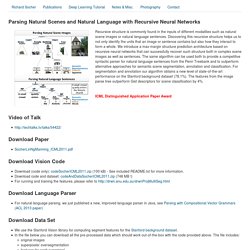
Save what you write before you post, then type in the password, post (nothing happens), then copy the text and re-post. It's to prevent spammers. I came across this on the Facebook group "Strong Artificial Intelligence" Thank you for the source code and all the explanations. I'd like to reference this page on the website of the hard science novel 'Memories with Maya' You'll understand my enthusiasm, because of the creative spin on AI done, in that story... Deep Learning: Recurrent Neural Networks in Python. Like the course I just released on Hidden Markov Models, Recurrent Neural Networks are all about learning sequences - but whereas Markov Models are limited by the Markov assumption, Recurrent Neural Networks are not - and as a result, they are more expressive, and more powerful than anything we’ve seen on tasks that we haven’t made progress on in decades.
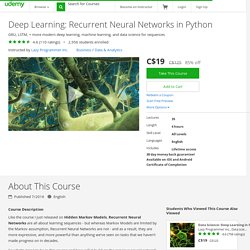
So what’s going to be in this course and how will it build on the previous neural network courses and Hidden Markov Models? In the first section of the course we are going to add the concept of time to our neural networks. I’ll introduce you to the Simple Recurrent Unit, also known as the Elman unit. Unsupervised Deep Learning in Python. Description This course is the next logical step in my deep learning, data science, and machine learning series.
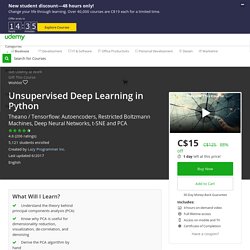
I’ve done a lot of courses about deep learning, and I just released a course about unsupervised learning, where I talked about clustering and density estimation. How to choose machine learning algorithms. The answer to the question "What machine learning algorithm should I use?
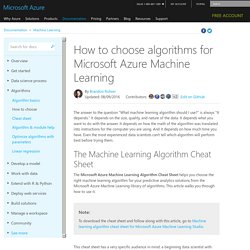
" is always "It depends. " It depends on the size, quality, and nature of the data. It depends what you want to do with the answer. It depends on how the math of the algorithm was translated into instructions for the computer you are using. Extracting, transforming and selecting features - Spark 2.0.1 Documentation. This section covers algorithms for working with features, roughly divided into these groups: Extraction: Extracting features from “raw” data Transformation: Scaling, converting, or modifying features Selection: Selecting a subset from a larger set of features Table of Contents Term frequency-inverse document frequency (TF-IDF) is a feature vectorization method widely used in text mining to reflect the importance of a term to a document in the corpus.

Denote a term by t, a document by d, and the corpus by D. Term frequency TF(t,d) is the number of times that term t appears in document d, while document frequency DF(t,D) is the number of documents that contains term t. Using of machine learning for invoice data recognition. Machine learning (ML) algorithms allows computers to define and apply rules which were not described explicitly by developer.

This algorithms can resolve at least the following kinds of problems: classification, clustering, regression. There are quite a lot of ways to apply these algorithms in business applications (here is one of general articles about it). Here we would like to give a high level description of how we apply these technology for invoice data recognition. TensorFlow Deep Learning Library. Machine Learning - Stanford University. Tutorial — Lasagne 0.2.dev1 documentation. Let’s now investigate what’s needed to make that happen!
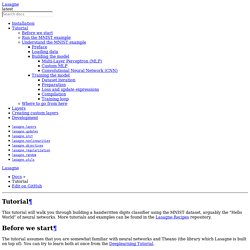
To follow along, open up the source code in your favorite editor (or online: mnist.py). Loading data¶ The first piece of code defines a function load_dataset(). Basic Tensor Functionality — Theano 0.8.2 documentation. Theano supports any kind of Python object, but its focus is support for symbolic matrix expressions.

When you type, the x is a TensorVariable instance. The T.fmatrix object itself is an instance of TensorType. Theano knows what type of variable x is because x.type points back to T.fmatrix. This chapter explains the various ways of creating tensor variables, the attributes and methods of TensorVariable and TensorType, and various basic symbolic math and arithmetic that Theano supports for tensor variables. Creation¶
APIs. Datasets. Considerations when setting up deep learning hardware. In last week’s blog post, I discussed my investment in an NVIDIA DIGITS DevBox for deep learning.

It was quite the investment, weighing in at a staggering (and wallet breaking) $15,000 — more than I ever thought I would spend on a computer that lives in my office (I normally like hardware that exists in the cloud where I don’t need to physically interact with it). That said, this is an investment that will drive the PyImageSearch blog over the coming months. I’ve made the commitment do to more more deep learning tutorials — specifically tutorials that involve Convolutional Neural Networks and image classification. In fact, over Memorial Day weekend, I spent two hours inside Trello brainstorming and planning the next year’s worth of tutorials on the PyImageSearch blog.
Getting Started with Deep Learning and Python. Update – January 27, 2015: Based on the feedback from commenters, I have updated the source code in the download to include the original MNIST dataset! No external downloads required! Update – March 2015, 2015: The nolearn package has now deprecated and removed the dbn module. When you go to install the nolearn package, be sure to clone down the repository, checkout the 0.5b1 version, and then install it. Do not install the current version without first checking out the 0.5b1 version! Time Series Prediction With Deep Learning in Keras.
Time Series prediction is a difficult problem both to frame and to address with machine learning. In this post, you will discover how to develop neural network models for time series prediction in Python using the Keras deep learning library. After reading this post you will know: About the airline passengers univariate time series prediction problem.How to phrase time series prediction as a regression problem and develop a neural network model for it.How to frame time series prediction with a time lag and develop a neural network model for it. Let’s get started.
My Top 9 Favorite Python Deep Learning Libraries. So you’re interested in deep learning and Convolutional Neural Networks. But where do you start? What is the Difference Between Deep Learning and “Regular” Machine Learning? 7 Steps to Mastering Machine Learning With Python. Getting started. Two of the most de-motivational words in the English language. Implementing a Neural Network from Scratch in Python – An Introduction – WildML.
Get the code: To follow along, all the code is also available as an iPython notebook on Github. A Neural Network in 11 lines of Python (Part 1) - i am trask. Python-machine-learning-book/README.md at master · rasbt/python-machine-learning-book. ImageSearchEngineResourceGuide. The 10 Algorithms Machine Learning Engineers Need to Know. Data types — NumPy v1.11 Manual. Array types and conversions between types Numpy supports a much greater variety of numerical types than Python does. This section shows which are available, and how to modify an array’s data-type. Additionally to intc the platform dependent C integer types short, long, longlong and their unsigned versions are defined. Numpy numerical types are instances of dtype (data-type) objects, each having unique characteristics.
Jupyter Notebook Viewer. So let us define the layers for the convolutional net. In general, layers are assembled in a list. Each element of the list is a tuple -- first a Lasagne layer, next a dictionary containing the arguments of the layer.
Introduction to Deep Neural Network Programming in Python – Derek Janni – Data Scientist. Generative Models. Neural networks and deep learning. CS231n Convolutional Neural Networks for Visual Recognition. Table of Contents: Convolutional Neural Networks are very similar to ordinary Neural Networks from the previous chapter: they are made up of neurons that have learnable weights and biases. Each neuron receives some inputs, performs a dot product and optionally follows it with a non-linearity.
Introduction to Deep Neural Network Programming in Python – Derek Janni – Data Scientist.